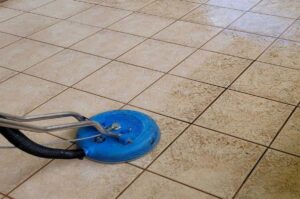Want to win more jobs with less effort?
Grow your business and send quick quotes with our home service software.

Want to see your potential revenue?
See what businesses like yours earn with Housecall Pro in 1 - 2 minutes.

Writing a business plan is one of the first steps of starting a cleaning business. It outlines the services you offer, your company’s legal structure, and how you’ll reach your goals. It also covers financial projections like startup costs, operating expenses, and expected income so you have a clear pathway to running a profitable cleaning company.
In this guide, we’ll walk you through the 12 steps of writing a business plan for a cleaning service company. By the end, you’ll have the tools you need to create your own cleaning business plan so you can keep yourself on track or present your vision to potential investors and secure funding.
→ Don’t want to write from scratch? Download Housecall Pro’s customizable home cleaning business plan template to make the process easier.
Key takeaways
Here’s a quick overview of how to write a cleaning business plan:
Know your market: Gather details about the local market and competitors beforehand so you have a good grasp of where your company fits in.
Define your business: Decide the cleaning services you want to offer, how much to charge, and the neighborhood you’ll serve.
Set clear goals: Include short- and long-term objectives to track growth and measure success.
Plan operations early: Document workflows, scheduling, and quality control to run a smooth, scalable business.
Create a marketing strategy: Outline how you’ll reach, convert, and retain customers using both online and local tactics.
Prepare financial projections: Include startup costs, operating expenses, and expected revenue to ensure profitability.
What to include in your cleaning company’s business plan
Your cleaning company’s business plan should include the following elements:
- Step 1: Cover page and table of contents
- Step 2: Executive summary
- Step 3: Business overview
- Step 4: Management team
- Step 5: Cleaning services list
- Step 6: Operations plan
- Step 7: Cleaning services pricing
- Step 8: Market analysis
- Step 9: Marketing strategy
- Step 10: Employee staffing
- Step 11: Financial planning
- Step 12: Appendix
- How Housecall Pro can help grow your cleaning business
We’ll walk you through each one in the sections below.
Step 1: Cover page and table of contents
Include a professional cover page that contains your business name and contact details (office address, phone number, and email)
Apart from your business name, the cover page should also include the following details:
- Logo and tagline
- Name of the owner and/or founder
- Mission or vision statement
Next, create a table of contents to help readers navigate with ease. A numbered list of your business plan’s sections makes the document scannable.
Step 2: Executive summary
The executive summary provides a snapshot of your entire cleaning service’s business plan. It helps readers understand what your cleaning company is about. Even though it appears first, it’s best to write this section last. That way, you’ll cover all the key details the plan contains.
Include these items in your executive summary:
- Business name and type: State your cleaning company’s name and the services you plan to offer.
- Mission statement: Explain what you do, the market segment you serve, and the overall purpose of your business.
- Business goals: List 2–3 short- and long-term objectives, such as gaining 20 recurring clients in your first six months or expanding to a neighboring city within a year.
- Unique selling point: Highlight what makes your cleaning company stand out from others in your area. Your differentiating feature could be 24/7 customer support, online booking convenience, or niche services, depending on your strengths and the market gaps you intend to fill.
Example:
“At Sparkle & Shine Cleaning Co., our mission is to provide eco-friendly home cleaning solutions. We focus on quality, reliability, and customer care. Serving households in Austin, Texas, we are committed to creating cleaner, healthier living spaces. We strive to set the standard for professionalism and sustainability in the home cleaning industry.”
Pro tip: Your executive summary should be no more than one page long.
Step 3: Business overview
This is where you’ll outline the structure of your cleaning business. This section explains who owns the company, what legal setup you’ve chosen, and which geographical areas you’ll serve.
Follow these best practices when writing the business overview:
- Specify your business type (e.g., sole proprietorship, limited liability company, or partnership).
- Mention the company’s owners or co-founders, and state their roles.
- Choose specific neighborhoods, cities, or regions where you will provide cleaning services.
- List what licenses or permits you need to legally operate in your proposed service area.
- Provide your business address, if applicable.
Also, include information about your insurance, such as general liability or workers’ compensation insurance, for legal protection. Don’t underestimate the importance of getting this set up before you launch.
“Insurance might feel like an extra expense, but it’s what keeps one bad day from wiping out everything you’ve built,” says Nick Disney, CEO of Sell My San Antonio House. He once worked with a cleaning company that secured three massive property management contracts within its first month. “That company’s owner didn’t get proper insurance before arriving at an $800,000 property, where cleaners broke a custom marble countertop worth $12,000. The incident caused the company to go bankrupt within 90 days.”
Step 4: Management team
Introduce the company owners and key team members, including marketing managers and team leads. List their names, titles, and primary responsibilities. Then, describe each person’s educational background and qualifications.
List relevant certifications or training, such as OSHA safety training and green cleaning certifications. If applicable, describe how the responsibilities are divided among team members. Identify who’s in charge of client relations, scheduling, marketing, accounting, and any other roles that exist within the company.
Pro tip: If you have yet to hire a team, showcase your expertise as proof that you’re capable of running the business. You can also outline the roles you plan to fill as your company expands.
Step 5: Cleaning services list
Your cleaning services list helps potential clients, partners, and investors understand your offerings. Depending on your specialty, these are examples of what to mention here:
- Regular cleaning
- Deep cleaning
- Airbnb cleaning
- Seasonal cleaning
- Move-in or move-out cleaning
- Post-construction or renovation cleaning
Also, describe specialty services or maintenance packages, like eco-friendly and pet-safe options. Specifying your services beforehand makes pricing easier to manage later on.
Learn more: 51 Types of Cleaning Services You Can Offer
Step 6: Operations plan
Your operations plan explains how your cleaning business functions day to day. It should show how you intend to implement a system that is efficient, consistent, and designed for growth.
Be sure to cover:
- Daily workflow: Outline how cleaning jobs are scheduled, assigned, and completed.
- Quality control: Describe your cleaning checklists, inspection routines, and customer feedback process to maintain high service standards.
- Tools and supplies: List your main cleaning equipment and trusted suppliers or bulk-purchase partners to manage costs.
- Scheduling system: Explain how clients book services, whether through a mobile app, your website, social media pages, or a phone call.
- Recordkeeping: Mention how you track income, expenses, and customer history using tools like QuickBooks for simple bookkeeping.
Step 7: Cleaning services pricing
Include a pricing strategy that factors in the cost of labor (including wages and taxes), supplies, and other operating expenses. The goal is to stay competitive without underpricing your services.
According to Brian Davis, the CEO of Handy Rubbish, underpricing is among the most common mistakes new business owners make. “New owners usually want to be the cheapest and that doesn’t leave any margin at all. Price for value, not volume,” he says.
To guide your pricing decisions, cover these areas in your business plan:
- Pricing model: Decide whether to charge an hourly or flat rate. Many cleaning businesses use a hybrid model, such as charging hourly for deep cleans and flat rates for recurring visits.
- Cost structure: Estimate the cost of labor, fuel, insurance, and overhead.
- Profit margins: Aim for a 20%–30% margin so you can invest back into the business and scale profitably.
- Competitive analysis: Analyze other cleaning businesses in your area and use their prices as a benchmark for setting your own rates.
- Discounts and loyalty programs: Create offers that will entice customers to use your cleaning services again and refer you to their friends and family.
Pro tip: When determining how much to charge, use real industry data and accurate cost ranges.
→ For more guidance on pricing, check out our cleaning cost guides and calculators:
- House cleaning price guide
- House cleaning service price calculator
- Commercial cleaning price guide
- Window cleaning price guide
- Carpet cleaning service price calculator
Step 8: Market analysis
Is your service in demand? What’s the competition like? These are two questions to ask when doing a market analysis. This step helps you understand the cleaning industry, your target market, and how to position your business for success.
Include these points in your cleaning market analysis:
- Market trends: You can mention eco-friendly or subscription-based cleaning, which are growing in popularity.
- Industry outlook: Research industry growth and report the findings. For example, the global cleaning services market is expected to hit $616.98 billion in annual revenue by 2030.
- Target market: Identify the target market for your cleaning services (for example, busy professionals or families with pets).
- Competitor data: Find out who your main competitors are, how much they charge, and how they market their cleaning services.
- Opportunities and threats: State what makes your company unique, what threats you might face, and growth opportunities to take advantage of.
Step 9: Marketing strategy
Your marketing plan outlines how you’ll guide customers through the buying funnel, from awareness to interest to desire and action. It should prove that you know where customers are, how to reach them, and how to convert (and retain) them.
An effective cleaning business marketing plan includes:
- Online advertising tactics, such as search engine optimization (SEO), paid ads, and social media marketing
- Local advertising strategies, including door hangers, flyers, business cards, and networking with other experts in your industry
- Referral programs, like offering discounts or a free service to customers who refer friends or family
→ For more guidance on how to advertise your business, check out our cleaning company marketing guide.
Pro tip: Use Housecall Pro’s automated marketing to send follow-up reminders, thank you messages, or limited-time offers to stay top-of-mind and generate repeat business.
Get In Touch: 858-842-5746
Let us earn your trust
On average, Pros increase monthly revenue generated through Housecall Pro by 50% after their first year.
See plan options and feature breakdown on our pricing page.
Step 10: Employee staffing
Note the number of cleaners, supervisors, or administrative staff you’ll need when starting up and when you plan to expand. Include information on:
- Hiring and onboarding: Plan the hiring process, from interviews to background checks. Then, create onboarding steps to get new hires up to speed on the company’s standards.
- Training: Document the training process for new hires, as well as safety procedures for all employees.
- Performance evaluation: Include ongoing performance reviews to maintain high service quality.
Even if you’re starting as a one-person operation, having these practices in place will help you scale effectively and protect your company long-term. “Your cleaners are your brand,” says Andriy Neborak, founder of Luxury Cleaning NY. “When you cut corners on hiring, you place everything in immediate jeopardy. Just one no-show or a betrayal of trust can destroy your reputation.”
Step 11: Financial planning
Highlight how your cleaning business will cover costs and stay profitable. April Prothero, founder of Going GreenHouse, says understanding your“costs, margins, and break-even point before building anything else is the first step to running a profitable cleaning business.
Let’s break these down:
- Startup costs: Estimate how much you will spend on cleaning equipment, supplies, licenses, marketing, and uniforms.
- Operating expenses: These include costs such as wages, cleaning supplies, maintenance, software subscriptions, and rent
- Revenue projections: Figure out how many clients you can service each week or month without burning out.
- Break-even point: Calculate the total jobs you will need per month to cover costs and make a profit.
Step 12: Appendix
The appendix is the last section of your business plan. Its purpose is to add credibility by including documents, certificates, and other related materials that support your claims.
Conclude your business plan with these details:
- Business registration documents, certifications, or proof of insurance
- Team member resumes or bios
- Marketing samples, such as flyers and website screenshots
- Financial documents, like quotes from suppliers, insurance estimates, and bank letters
- A cleaning price list template for quick reference
How Housecall Pro can help grow your cleaning business
New cleaning companies often neglect systems like scheduling, payments, and training. Without these, jobs slip through the cracks, customers get frustrated, and growth becomes a lot harder than it needs to be. That’s where Housecall Pro makes a difference.
Housecall Pro is a field service management platform designed to keep your cleaning business organized while scaling. It helps you put the right systems in place early and allows you to manage them all from one platform—anytime, anywhere.
With our cleaning business software, you can:
- Assign cleaners on the go.
- Let clients book your service directly from your website or social media page.
- Send automatic reminders to reduce no-shows.
- Create and send branded digital quotes, estimates, and invoices in minutes.
- Automate review requests, follow-up offers, and recurring cleaning reminders to stay top of mind with customers.
- Accept card or mobile payments and get paid faster.
Take Housecall Pro for a spin with our 14-day free trial, and start simplifying your operations today.
FAQ
-
What type of cleaning makes the most money?
-
Specialized services like deep cleaning, move-in/move-out cleaning, post-construction cleaning, and short-term rental turnovers tend to be the most profitable. These jobs require more skill and time, so customers are willing to pay higher rates.
-
How much should I pay a cleaner per hour?
-
Most cleaning businesses pay cleaners $15–$25 per hour, depending on location and experience. Make sure to factor in taxes and training so you can offer competitive pay while still maintaining healthy margins.
-
How much cleaning can be done in three hours?
-
In three hours, you can finish a full standard clean for a small- to medium-sized home. That means the kitchen, bathrooms, and main living space. The exact result depends on the home’s condition, your pace, and whether or not you have employees.





